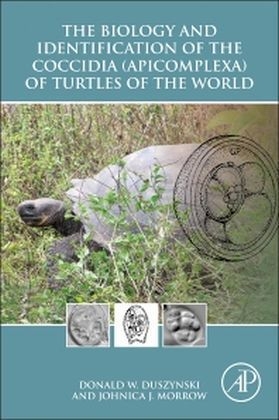
The Biology and Identification of the Coccidia (Apicomplexa) of Turtles of the World
Academic Press Inc (Verlag)
978-0-12-801367-0 (ISBN)
There are about 330 turtle species on Earth; many are endangered, a growing number of species are kept as pets, and some are still used as food by humans. Turtles, like other vertebrate animals have many different kinds of parasites (viruses, bacteria, protozoa, worms, arthropods, and others). Coccidiosis in turtles has prevented large-scale turtle breeding, and represents a serious problem in need of control. This succinct and highly focused book will aid in that effort.
Dr. Duszynski, is Professor Emeritus Biology and past Chair of the Department of Biology, The University of New Mexico (UNM). He spent 33 years in academia, publishing numerous articles, monographs, and books, secured private, state and federal grants exceeding $8 million, and mentored > 25 masters and doctoral students and numerous undergraduates in his laboratory, before spending 8 years in administration. During his 41 year tenure at UNM, he taught many courses including parasitology, tropical biology and marine invertebrate biology, and took >1000 students to the neotropics (Belize, Jamaica, Mexico). Don has been a Visiting Research Associate Professor, Department of Physiology & Biochemistry, University of Texas Health Science Center, Houston, a Visiting Associate Professor, Department of Microbiology, University of Texas Medical Branch, Galveston, and Visiting Research Scholar, Kyoto University, Japan. Among the honors received are the Distinguished Service Award and the Clark P. Read Mentor Award from the American Society of Parasitologists (ASP), and the Distinguished Alumnus Award from the Department of Biology, Colorado State University. Johinca Morrow is a doctoral student pursuing a degree of Applied Ecology in the School of Natural Resources at the University of Nebraska-Lincoln (UN-L). She holds a M.S.in general biology and a B.S.in organismal biology from Midwestern State University (MSU), Wichita Falls, TX. She has been teaching biology since 2008 and served as assistant to the Associate Director of Cedar Point Biological Station (summer, 2013). Her honors include several President’s scholarships, the Beyer-Abbott Scholarship for excellence in biology , and a graduate student merit scholarship (MSU). As an undergraduate she was a member of MSU’s Honor Society, Beta Beta Beta, and Phi Alpha Theta, as well as a member of Who’s Who Among American Colleges and Universities (2009). Shewas nominated as a member of the Golden Key International Honor Society (2012). As a graduate student, she has become an active member of the American Society of Parasitologists (ASP), the Southwestern Association of Parasitologists (SWAP), and the Rocky Mountain Conference of Parasitologists (RMCP). She is broadly interested in parasite biology, but is focusing her attention on the field of archaeoparasitology as a doctoral student.
Preface and AcknowledgmentsChapter One: IntroductionChapter Two: Suborder CryptodiraChapter Three: Suborder PleurodiraChapter Four: Cryptosporidium, Sarcocystis, & Toxoplasma in TurtlesChapter Five: Species Inquirendae in TurtlesChapter Six: Discussion and SummaryLiterature Cited/References
| Verlagsort | San Diego |
|---|---|
| Sprache | englisch |
| Maße | 152 x 229 mm |
| Gewicht | 330 g |
| Themenwelt | Medizin / Pharmazie |
| Naturwissenschaften ► Biologie ► Mikrobiologie / Immunologie | |
| Naturwissenschaften ► Biologie ► Zoologie | |
| Veterinärmedizin ► Klinische Fächer ► Parasitologie | |
| ISBN-10 | 0-12-801367-2 / 0128013672 |
| ISBN-13 | 978-0-12-801367-0 / 9780128013670 |
| Zustand | Neuware |
| Haben Sie eine Frage zum Produkt? |
aus dem Bereich


